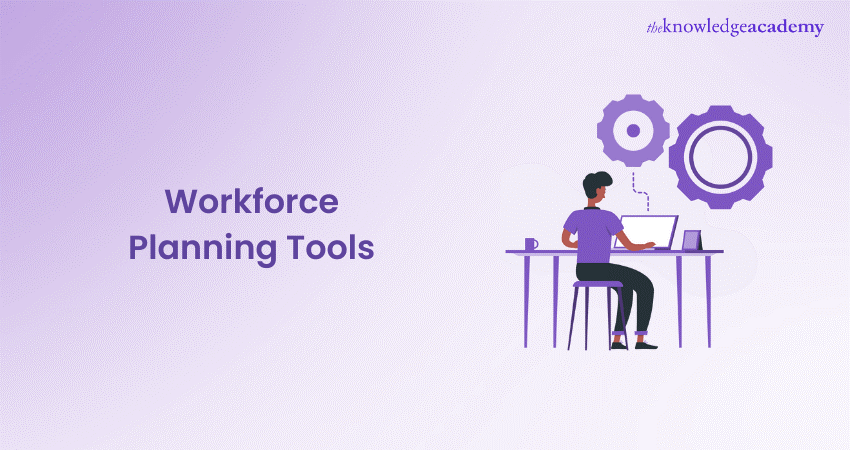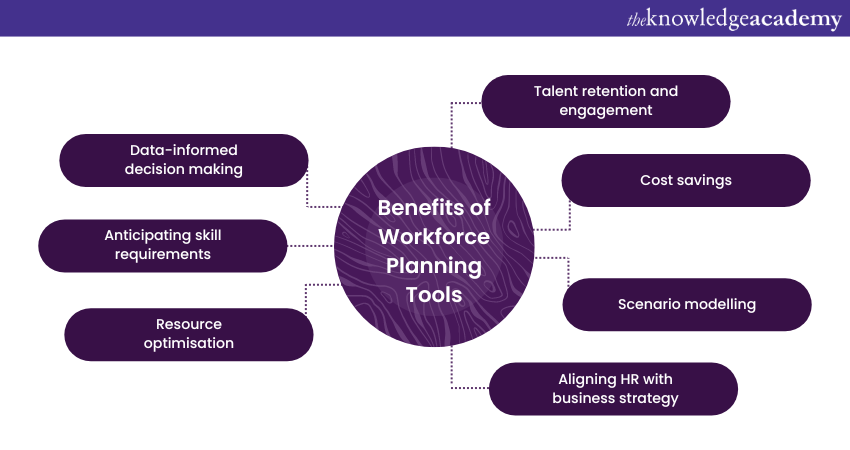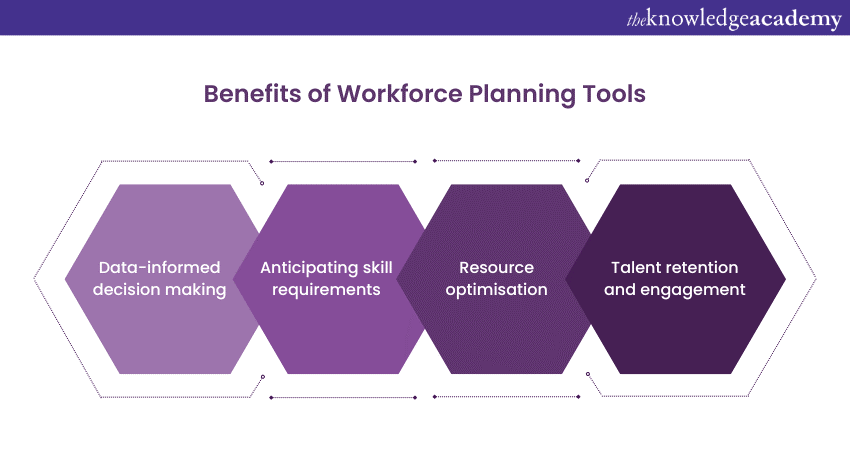We may not have the course you’re looking for. If you enquire or give us a call on +91-181-5047001 and speak to our training experts, we may still be able to help with your training requirements.
Training Outcomes Within Your Budget!
We ensure quality, budget-alignment, and timely delivery by our expert instructors.

In today's business landscape, achieving and maintaining a competitive edge requires more than innovative products and services. It delegates a strategic approach to managing resources, particularly regarding the heart of any organisation: its workforce. This is where the "Workforce Planning Tools" concept comes into the picture. Organisations must adapt quickly to stay ahead in an era marked by dynamic market conditions, fluctuating consumer demands, and technological advancements. This adaptation extends to the way companies approach their staffing strategies.
As organisations grapple with the complexities of maintaining an agile and efficient workforce, integrating Workforce Planning Tools has become less of a luxury and more of a necessity. From ensuring the proper staffing levels to anticipating skill gaps and addressing turnover, these tools provide the insights and analytical prowess required to make informed decisions. In this blog, we will explore benefits, features, and the steps to effectively utilise Workforce Planning Tools and gain insight into how these tools assist in strategic workforce management.
Table of contents
1) The importance of Workforce Planning
2) Common challenges in staffing
3) Benefits of Workforce Planning Tools
4) Key features to look for in Workforce Planning Tools
5) Best Workforce Planning Tools in the industry
6) Implementing Workforce Planning Tools: A step-by-step guide
7) Conclusion
The Importance of Workforce Planning
Workforce Planning Tools have emerged as a pivotal solution for modern businesses seeking to optimise their human capital utilisation. These tools encapsulate a range of technologies and methodologies designed to align an organisation's staffing needs with its broader strategic objectives. These tools empower companies to navigate the intricate maze of recruitment, staffing, and talent management with precision and foresight. In this section, we will look into the importance of Workforce Planning:

Anticipating staffing needs
Workforce planning is not limited to filling vacant positions; it's about predicting future requirements. Organisations can accurately forecast staffing needs by analysing historical data, market trends, and projected growth. This predictive insight safeguards against both under-staffing, which could hamper operations, and over-staffing, which could inflate costs.
Alignment with business objectives
The workforce planning process necessitates thoroughly understanding an organisation's strategic goals. This alignment ensures that every hiring decision contributes directly to achieving these objectives. Whether it's expansion into new markets, diversification of services, or technological innovation, workforce planning ensures the availability of the right talent at the right time.

Mitigating turnover impact
High employee turnover can be detrimental to productivity and morale. Through comprehensive workforce planning, organisations can identify factors contributing to turnover and take proactive measures to address them. This might include enhanced employee engagement initiatives, targeted skill development, or a more competitive compensation structure.
Adapting to technological advances
Automation and artificial intelligence have transformed industries, altering the skill sets demanded by the workforce. Effective workforce planning identifies these evolving skill needs and devises strategies to upskill existing employees or attract new talent with the required proficiencies.
Cost efficiency and resource optimisation
Without proper planning, staffing decisions can lead to unnecessary expenses. Workforce planning optimises resource allocation by strategically distributing human capital where needed most. This not only curtails costs but also enhances operational efficiency.
Agility in an uncertain environment
The business landscape is rife with uncertainties, from economic fluctuations to unforeseen global events. Workforce planning equips organisations to respond swiftly to these uncertainties with contingency plans, ensuring that essential functions remain unhindered.
Learn about workforce planning and labour market change in the organisations, sign up for our Workforce Resource Planning Training now!
Common challenges in staffing
Navigating the complex terrain of staffing is no small feat, as organisations grapple with many challenges that can hinder their operational efficiency and growth. Here, we uncover some of the most prevalent hurdles companies encounter and discuss how these challenges underscore the importance of efficient workforce planning.
Overstaffing and understaffing
Finding the delicate balance between having enough staff to meet demands and not overburdening the organisation with surplus employees is a perennial challenge. Overstaffing strains resources and inflates costs, while understaffing can lead to burnout, decreased productivity, and poor customer service. Workforce planning offers a strategic remedy by aligning staffing levels with actual needs.
Skill gaps and mismatched competencies
As industries evolve, so do the skill requirements. Organisations often need help to identify and bridge skill gaps within their workforce. Mismatched competencies can hinder project execution and innovation. Workforce planning helps identify emerging skill needs and provides insights into upskilling or hiring efforts to ensure the right expertise is available.
Employee turnover
High turnover rates disrupt team dynamics, hinder knowledge retention, and strain HR resources. Identifying the reasons behind turnover and devising strategies to enhance employee engagement and job satisfaction is critical. Workforce planning allows organisations to predict turnover trends and take proactive measures to retain valuable talent.
Diversity and inclusion
Garnering a diverse and inclusive workforce is a complex challenge that organisations face. Hiring a diverse talent pool and ensuring an inclusive work environment can improve creativity, innovation, and employee satisfaction. Workforce planning facilitates the intentional recruitment of candidates and the implementation of inclusive policies.
Rapid technological advancements
Technological advancements can render specific job roles obsolete while creating demand for new skill sets. Organisations must stay ahead of these changes to ensure their workforce can handle evolving tasks. Workforce planning anticipates such shifts and guides training and recruitment strategies accordingly.
Aging workforce and succession planning
Many industries are witnessing the impending retirement of senior employees, raising concerns about knowledge transfer and leadership succession. Effective succession planning involves identifying potential successors, nurturing their growth, and ensuring a smooth transition—Workforce Planning Tools aid in identifying potential gaps in leadership and expertise.
Gain skills to become a capable leader, sign up for Management Training now!
Benefits of Workforce Planning Tools
Amid the intricate dance of managing a workforce, technology becomes indispensable. Workforce Planning Tools orchestrate data-driven insights, predictive analytics, and strategic foresight, providing organisations with benefits that elevate their staffing strategies.

Data-informed decision making
Workforce Planning Tools are a treasure trove of data, enabling organisations to make informed decisions based on concrete insights rather than intuition. From historical performance metrics to future projections, these tools allow HR professionals and management to identify trends, anticipate needs, and make precise decisions.
Anticipating skill requirements
The evolving business landscape demands agility in skill acquisition. Workforce Planning Tools analyse market trends and technological advancements to identify the skills in demand. This foresight empowers organisations to proactively train their existing workforce or attract new talent, ensuring a continuous alignment with industry needs.
Resource optimisation
Practical Workforce Planning Tools help organisations optimise their resource allocation. Companies can streamline staffing levels by understanding peak periods, identifying surplus capacities, and addressing skill gaps. This enhances operational efficiency and curtails unnecessary expenses associated with overstaffing.
Talent retention and engagement
Employee turnover can be a costly affair. Workforce Planning Tools analyse factors contributing to turnover, enabling organisations to design targeted retention strategies. By identifying engagement trends, organisations can create a work environment that caters to employee satisfaction and loyalty.
Cost savings
Financial implications are never far behind in the intricate web of staffing decisions. Workforce Planning Tools assist in calculating the cost of staffing decisions, aiding organisations in making choices that align with their budget constraints. This strategic financial approach prevents overspending and promotes a lean staffing strategy.
Scenario modelling
Workforce Planning Tools empower organisations to simulate different scenarios, such as expansion, downsizing, or changes in project volume. This capability allows for strategic evaluation of the outcomes of various decisions before they are implemented, reducing the risk of missteps.
Aligning HR with business strategy
Gone are the days when HR was confined to administrative tasks. Workforce Planning Tools elevate HR to a strategic partner, aligning its efforts with overarching business goals. HR becomes an integral driver of success by contributing to organisational growth strategies.
Key features to look for in Workforce Planning Tools
In a world where data reigns supreme, suitable features in Workforce Planning Tools can make all the difference in optimising staffing strategies. These tools have evolved into sophisticated platforms that amalgamate data analysis, predictive modelling, and strategic insights. Here's a closer look at the key features organisations should seek when considering Workforce Planning Tools.
Forecasting capabilities
Accurate predictions lie at the heart of effective workforce planning. Advanced tools harness historical data and trends to forecast future staffing needs. These forecasts act as a compass, guiding organisations toward staffing decisions aligned with projected demand.
Data visualisation
Numbers alone may not convey the complete picture. Workforce Planning Tools with robust data visualisation capabilities transform complex data sets into understandable visuals. This empowers decision-makers to quickly grasp trends, patterns, and anomalies, enabling faster and more informed choices.
Scenario modelling and simulations
The ability to simulate various scenarios is invaluable. Tools that allow users to model different staffing scenarios—such as expansion, market shifts, or seasonal fluctuations—help organisations assess potential outcomes before making decisions. This minimises risks associated with uninformed choices.
Skill gap analysis
Identifying skill gaps is crucial for targeted training and recruitment. Workforce Planning Tools that analyse existing skills within the workforce and compare them against anticipated skill requirements can guide professional development initiatives and hiring strategies.
Integration with HR and management systems
Seamless integration with existing HR and management systems is a game-changer. This feature enables a unified view of workforce data, ensuring that staffing decisions are informed by real-time information from various organisational departments.
Predictive analytics
Predictive analytics take workforce planning to the next level. These tools leverage historical data and algorithms to anticipate future trends, enabling organisations to make proactive decisions rather than reactive adjustments.
Scalability and flexibility
As organisations grow, their staffing needs change. Workforce Planning Tools should be scalable and capable of accommodating the expanding demands of an evolving organisation. Flexibility to adapt to changing industry dynamics and strategies is also essential.
Collaboration and reporting
Efficient collaboration and reporting functionalities ensure that relevant stakeholders are on the same page. Workforce Planning Tools that facilitate easy sharing of insights, reports, and recommendations enhance communication and decision-making.
Learn about workforce planning tools for the reduction of work, sign up for our Workforce Resource Planning Training now!
Best Workforce Planning Tools in the industry
This section will look at some examples of Workforce Planning Tools.

Runn
Runn is among the best Workforce Planning Tools used in workforce planning for consulting, agency, and software businesses. It assists in managing workloads quickly and easily, understanding profitable roles and forecasting future needs. Runn's People Planner compares capacity with confirmed workloads and provides insight into everyone's bookings. Runn's reports provide planning, tracking and forecasting in a single place, with automated insights into how staff are being utilised to assign tasks based on availability. Identifying business areas that are at limit significantly improves strategic workforce planning, enabling talent and skills to deliver on business requirements.
Paymo
Paymo assists in reducing meetings focused on finding out who is available to work in remote or hybrid work arrangements. Paymo's Team Scheduler provides insight into who is over or under booked. Paymo provides a feature to drag and drop unscheduled work on the timeline to adjust workload as required.
Paymo's People module provides project managers and the HR department with an overview of employee data, from legal leaves to employee performance and timesheets. Managers can individually control days off, such as sick leaves, paid sabbaticals, casual leaves, etc., or holidays in bulk, such as national holidays for the entire team, at the ease of a few clicks.
Bizimply
Unlike other Workforce Planning Tools suitable for project-oriented models, Bizimply is designed to cater to healthcare, retail, and hospitality industries to simplify employee scheduling and workforce planning. Bizimply's software solution improves efficiency by streamlining people's shifts and schedules, resulting in profitability. Their management solution enables improving shift-oriented business models by optimising people's journey on factors such as employee scheduling, shift time and attendance.
Quinyx
Quinyx integrates AI to implement strategic workforce capacity planning. It assists industries that are dynamic in nature by identifying peak and dull times down to 15-minute intervals. Delivering accurate business activity forecasts, it analyses areas of activity to report the number of employees needed in each role to meet demand and optimal labour hours.
Planday
Planday is a Workforce Planning tool that provides detailed employee schedule information. Planday offers various features to plan workforce hours and track business goals. Planday assists in faster employee scheduling by considering factors such as staff vacation, availability, and payroll costs. This software boasts features such as staff management, scheduling, punch clock, reporting and integration with various tools businesses use daily.
Implementing Workforce Planning Tools: A step-by-step guide
Integrating Workforce Planning Tools into an organisation's framework isn't just about acquiring software; it's a strategic transformation that requires careful planning and execution. Here's a comprehensive step-by-step guide to successfully implementing Workforce Planning Tools and harnessing their potential.
Step 1: Identifying staffing needs
Begin by defining the organisation's short-term and long-term staffing needs. Consider projected growth, market trends, and evolving skill requirements. This clarity lays the foundation for effective workforce planning.
Step 2: Data collection and analysis
Gather relevant data, including historical staffing patterns, turnover rates, and performance metrics. Clean, accurate data forms the bedrock of informed decision-making—Utilise Workforce Planning Tools to analyse this data for insights.
Step 3: Selecting the right tool
Choose a workforce planning tool that aligns with your organisation's size, industry, and objectives. Consider factors such as scalability, integration capabilities, and the specific features that meet your needs.
Step 4: Training and onboarding
A tool is only as effective as its users. The tool provides comprehensive training to the HR team, managers, and stakeholders. Ensure they understand how to input data, interpret insights, and make informed decisions.
Step 5: Integration with HR and management systems
Seamlessly integrate the new tool with existing HR and management systems to ensure a unified view of workforce data. This integration facilitates efficient data sharing and informed decision-making across departments.
Step 6: Piloting and testing
Before full implementation, conduct a pilot phase with a smaller team or project. This allows you to identify glitches, fine-tune processes, and ensure the tool aligns with your organisation's needs.
Step 7: Feedback and iteration
Gather feedback from users during the pilot phase and initial implementation. Use this input to make necessary adjustments and improvements. Continuous iteration ensures that the tool remains aligned with evolving needs.
Step 8: Communication and change management
Communication is vital. Communicate the new tool's purpose, benefits, and expectations to all stakeholders. Address any concerns and emphasise its positive impact on staffing strategies.
Step 9: Monitoring and continuous improvement
Regularly monitor the tool's performance and its impact on staffing decisions. Analyse whether it's meeting its intended goals and identify areas for improvement. Stay open to updates and enhancements.
Step 10: Integration with organisational strategy
Integrate the insights derived from the workforce planning tool into broader organisational strategies. Use the data to inform growth initiatives, resource allocation, and skill development efforts.
Conclusion
In the business landscape, Workforce Planning Tools have emerged as indispensable allies for organisations seeking agility and precision in staffing. By aligning staffing needs with strategic goals, harnessing predictive insights, and fostering data-driven decision-making, these tools pave the way for smarter and more efficient staffing solutions.
Learn how to manage and solve problems using various strategies, sign up for our Problem-Solving Training now!
Frequently Asked Questions
Upcoming Business Skills Resources Batches & Dates
Date
 Workforce Resource Planning Training
Workforce Resource Planning Training
Fri 28th Feb 2025
Fri 4th Apr 2025
Fri 27th Jun 2025
Fri 29th Aug 2025
Fri 24th Oct 2025
Fri 5th Dec 2025







 Top Rated Course
Top Rated Course


 If you wish to make any changes to your course, please
If you wish to make any changes to your course, please


